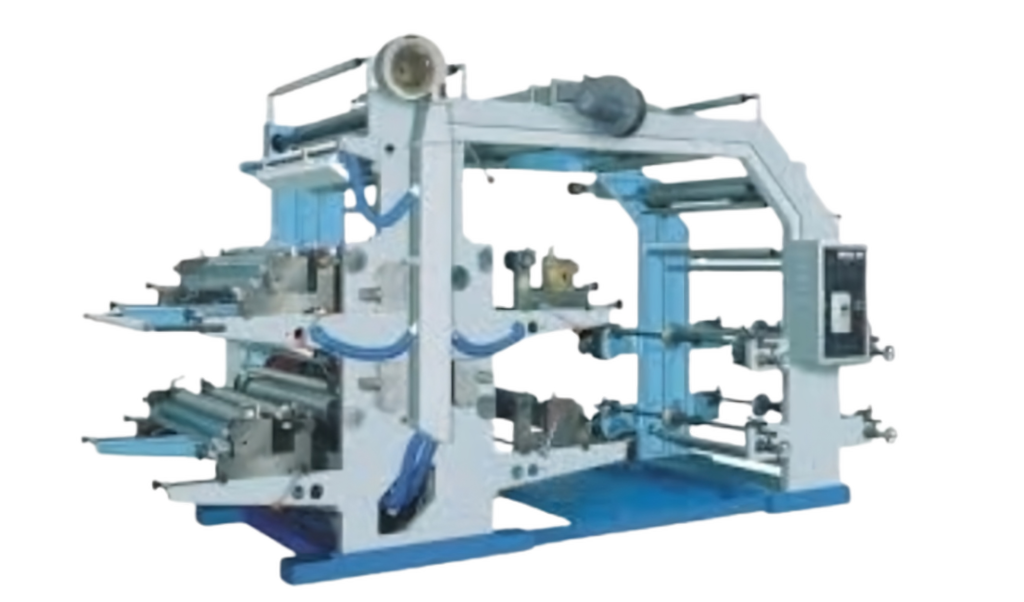
Flexographic Printing Machine – Abhisara International
Woven Sack Bag Stitching Machine
System Components:
- Stitching Head
- Description: High-performance stitching unit for sewing woven sack bags.
- Function: Provides precise stitching to secure sack panels and closures.
- Fabric Feed Mechanism
- Description: System for feeding woven fabric panels into the stitching area.
- Function: Ensures consistent and smooth feeding of material for accurate stitching.
- Needle and Thread System
- Description: Advanced needle and thread mechanism for durable stitching.
- Function: Uses heavy-duty needles and threads to handle thick woven fabrics.
- Cutting and Trimming Unit
- Description: Unit for cutting excess fabric and trimming thread ends.
- Function: Ensures neat and clean edges for finished sack bags.
- Bag Handling System
- Description: Mechanism for moving and positioning bags during the stitching process.
- Function: Facilitates smooth handling and positioning of sacks for stitching.
- Control Panel
- Description: Centralized interface for managing machine operations and settings.
- Function: Provides real-time monitoring, adjustments, and control over the stitching process.
- Inspection and Quality Control Station
- Description: Area for inspecting stitched sacks for defects and quality assurance.
- Function: Ensures that all stitched sacks meet quality standards and specifications.
Operation Process:
- Fabric Feeding
- Process: Woven fabric panels are fed into the stitching machine using the fabric feed mechanism.
- Outcome: Panels are positioned for accurate stitching.
- Stitching
- Process: The stitching head secures the panels with precise stitches, creating the bag shape.
- Outcome: Panels are stitched together to form completed sack bags.
- Cutting and Trimming
- Process: Excess fabric is cut and thread ends are trimmed.
- Outcome: Neat and clean edges are achieved for the finished sacks.
- Bag Handling
- Process: Bags are moved and positioned for stitching by the handling system.
- Outcome: Efficient and accurate stitching of sack bags.
- Inspection and Quality Control
- Process: Stitched sacks are inspected for defects and quality assurance.
- Outcome: Ensures that all bags meet the required quality standards.
Features:
- High-Performance Stitching Head: Provides precise and durable stitching for woven sack bags.
- Efficient Fabric Feed Mechanism: Ensures smooth and consistent feeding of fabric panels.
- Heavy-Duty Needle and Thread System: Handles thick woven fabrics with ease.
- Integrated Cutting and Trimming Unit: Delivers clean edges and finishes for sacks.
- Versatile Bag Handling System: Facilitates smooth movement and positioning of bags.
- User-Friendly Control Panel: Allows for easy monitoring and adjustments of machine settings.
- Robust Quality Control: Comprehensive inspection to ensure high-quality output.
Benefits of Using the Woven Sack Bag Stitching Machine:
- Efficient Production: Streamlined stitching process enhances productivity and reduces manual labor.
- Durable Bags: Provides strong and reliable stitching for long-lasting sack bags.
- Customizable Design: Capable of stitching various sizes and types of woven sacks.
- Enhanced Quality Control: Ensures consistent quality and reduces defects in finished sacks.
- Reduced Labor Costs: Automation minimizes the need for manual intervention, improving efficiency.
Specifications:
- Stitching Speed: Adjustable based on production requirements and fabric types.
- Fabric Panel Size: Customizable to accommodate different sack sizes.
- Needle and Thread Specifications: Suitable for handling various woven fabric thicknesses.
- Control Panel Features: Includes real-time data display, system status, and adjustment options.
- Customizable Specifications: Machine specifications can be tailored to meet specific customer needs.
How It Works:
- Feeding: Woven fabric panels are fed into the machine and positioned for stitching.
- Stitching: Panels are stitched together to form the sack shape.
- Cutting and Trimming: Excess fabric and thread ends are removed for a clean finish.
- Handling: Bags are efficiently moved and positioned for accurate stitching.
- Inspection: Stitched sacks are inspected to ensure they meet quality standards.
Abhisara International’s Woven Sack Bag Stitching Machine offers a comprehensive solution for efficiently producing high-quality stitched woven sacks, enhancing productivity and ensuring consistent quality in various industrial applications.
